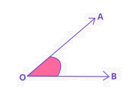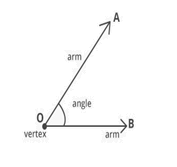CLASS-6
ANGLE
ANGLE -
An angle is a geometric figure formed by two rays or line segments that share a common endpoint, called the vertex of the angle. These rays or line segments extend in different directions from the vertex. Angles are used to measure the amount of rotation or separation between these two rays and are typically expressed in degrees, radians, or other angular units.

What is an Angle?
In geometry, an angle can be defined as the figure formed by two meeting at a common end point. An angle is represented by the symbol ∠. Here, the angle below is ∠AOB.
Key components of an angle include:
- Vertex:- The common endpoint where the two rays or line segments meet.
- Arms:- The two rays or line segments that form the sides of the angle. They extend outward from the vertex.
- Interior:- The space enclosed by the angle, which is the region between the two arms.
- Exterior:- The space outside the angle, which is the region not enclosed by the angle.
Parts Of an Angle:-
Arms:- The two rays joining to form an angle are called arms of an angle. Here, OA and OB are the arms of the ∠AOB.
Vertex:- The common end point at which the two rays meet to form an angle is called the . Here, the point O is the vertex of ∠AOB.

The measure of an angle indicates how much one ray needs to be rotated or turned to align with the other ray, typically measured in degrees (°) or radians (rad). A full rotation around a point is 360 degrees or 2π radians.
Angles are used extensively in geometry, trigonometry, and various fields of science and engineering to describe shapes, positions, and relationships between objects. Common types of angles include acute angles (measuring less than 90 degrees), right angles (measuring 90 degrees), obtuse angles (measuring more than 90 degrees but less than 180 degrees), and straight angles (measuring 180 degrees). Angles also play a crucial role in trigonometric functions and the study of periodic phenomena.